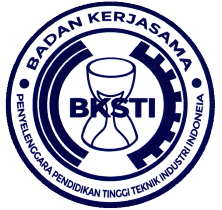Studi Potensi Industri Selulosa Nanokristalin dari Tandan Kosong Kelapa Sawit di Indonesia: Analisis SWOT dan Lokasi Pabrik
DOI:
https://doi.org/10.52759/inventory.v6i1.239Keywords:
Bioprocess Technology, Palm Empty Fruit Bunches, Factory Location, Nanocrystalline CelluloseAbstract
Oil palm empty fruit bunches (OPEFB), comprising 25-26% of fresh fruit bunches, contain up to 38.70% cellulose, making them a promising raw material for nanocrystalline cellulose (NCC) production. Bioprocess technology for producing NCC from OPEFB has been developed, with potential for industrial-scale application. This research analyzes potential factory locations for NCC production in the Sumbar-Riau region, Indonesia, using the value assessment method and complemented by SWOT, IFE, and EFE analyses. The assessment involved a team of 13 experts from the palm oil industry, including senior management from five different palm oil companies, who contributed to assessment through a Focus Group Discussion (FGD). The Kampar area in Riau was identified as the optimal location, scoring 82 out of 100, based on factors like raw material availability, market access, infrastructure, and labor. The SWOT analysis, supported by IFE (2.05) and EFE (2.65) scores, places Kampar in the S-O strategy quadrant, indicating a strong internal position and significant external opportunities. The recommended location in Kampar, with a production capacity of 2,000 tons/year, offers strategic advantages for NCC production. These results provide valuable insights for stakeholders, including investors, government, and industry, for developing the NCC industry in Indonesia, particularly in the Sumbar-Riau region.
Downloads
References
R. Y. H. Silitonga, S. N. Bahagia, T. Simatupang, and J. Siswanto, “Modeling the Competitiveness of Indonesian Palm Oil Industry: A Conceptual Model Using Hierarchical Multi-Level System Approach,” J. Tek. Ind., 2013, doi: 10.9744/jti.15.2.103-110.
M. Siahaan, “Palm oil industry in Indonesia- statistics & facts,” statista. [Online]. Available: https://www.statista.com/topics/5921/palm-oil industry-in-indonesia/#topicOverview
H. Saputra, W. Panggabean, and D. F. Simatupang, “Fabrikasi Material Bioplastik Dari Selulosa Hasil Ekstraksi Tandan Kosong Kelapa Sawit,” Sang Pencerah J. Ilm. Univ. Muhammadiyah But., vol. 9, no. 1, 2023, doi: 10.35326/pencerah.v9i1.3035.
M. O. Adu et al., “The use of oil palm empty fruit bunches as a soil amendmentto improve growth and yield of crops. A meta-analysis,” Agron. Sustain. Dev., 2022, doi: 10.1007/s13593-022 00753-z.
J. Han and J. Kim, “Process Simulation and Optimization of 10-MW EFB Power Plant,” in Computer Aided Chemical Engineering, 2018. doi: 10.1016/B978-0-444-64235-6.50128-5.
N. B. Osman, N. Shamsuddin, and Y. Uemura, “Activated Carbon of Oil Palm Empty Fruit Bunch (EFB); Core and Shaggy,” in Procedia Engineering, 2016. doi: 10.1016/j.proeng.2016.06.610.
F. S. Irwansyah, J. Yanto, W. D. I. Azis, and Kelvin, “Optimization of Empty Fruit Bunches (EFB) as a solution to deforestation as a result of the exploitation from the paper industry in Riau of conferences,” in IOP Conference Series: Materials Science and Engineering, 2018. doi: 10.1088/1757-899X/434/1/012189.
M. Amrullah, E. Mardawati, R. Kastaman, and S. Suryaningsih, “Study of bio-briquette formulation from mixture palm oil empty fruit bunches and palm oil shells,” in IOP Conference Series: Earth and Environmental Science, 2020. doi: 10.1088/1755-1315/443/1/012079.
Maryam, K. Akli, and M. Isfus Senjawati, “Bioproses Pembuatan Nano Crystallin Cellolose (NCC) dari Tandan Kosong Kelapa Sawit (TKKS) dan Aplikasinya Sebagai Material Komposit Bioplastik,” 2020.
K. rimadhanti Ningtyas, M. Muslihudin, and I. N. Sari, “Sintesis Nanoselulosa dari Limbah Hasil Pertanian dengan Menggunakan Variasi Konsentrasi Asam,” J. Penelit. Pertan. Terap., 2020, doi: 10.25181/jppt.v20i2.1631.
F. Aulia, Marpongahtun, and S. Gea, “Studi Penyediaan Nanokristal Selulosa Dari Tandan kosong sawit (TKS),” J. Saintia Kim., 2013.
W. Neng, D. Enyong, and C. Rongshi, “Preparation and liquid crystalline properties of spherical cellulose nanocrystals,” Langmuir, 2008, doi: 10.1021/la702923w.
O. Riza, S. Nikmatin, H. Hardhienata, and F. A. Syamani, “Analisa Sifat Mekanik pada Bahan Anti Peluru dari Adisi Berpenguat Serat Panjang Tandan Kosong Kelapa Sawit (TKKS),” Newton Maxwell J. Phys., vol. 3, no. 1, 2022, doi: 10.33369/nmj.v3i1.17567.
I. Hidayatulloh, E. M. Widyanti, C. Aztaris, A. Melanitria, and Lidya Elizabeth, “Kajian Pustaka Sintesis Nanoselulosa dari Tandan Kosong Kelapa Sawit sebagai Filler Pembuatan Tisu Toilet,” Fluida, vol. 15, no. 1, 2022, doi: 10.35313/fluida.v15i1.2711.
S. Hidayat, A. Meidinariasty, and R. Junaidi, “Film Nanokomposit Berbasis Termoplastik Pati Singkong -Polivinil Alkohol Dengan Nanoselulosa Tandan Kosong Kelapa Sawit (TKKS) Sebagai Bahan Penguat,” J. Pendidik. dan Teknol. Indones., vol. 2, no. 10, 2022, doi: 10.52436/1.jpti.225.
R. Yudianti, Pengembangan Nanokomposit Berbasis Nanoselulosa dan Nanokarbon sebagai Material Fungsional. 10.55981/brin.431. 2022. doi: M. R. Store, “Global Nanocellulose (Nano crystalline Cellulose, Nano-fibrillated Cellulose and Bacterial Nanocellulose) Market Set for Rapid Growth, To Reach Around USD 530.0 Million by 2021,” Market Research Store. Accessed: Mar. 21, 2024. [Online]. Available: https://www.marketresearchstore.com/news/glob al-nanocellulose-market-223
nanografi, “Cellulose Nanocrystal (Nanocrystalline Cellulose,CNC).” Accessed: Mar. 21, 2024. [Online]. Available: https://nanografi.com/popular-products/cellulose nanocrystal-nanocrystalline-cellulose-cnc/
Y. Tang, X. Shen, J. Zhang, D. Guo, F. Kong, and N. Zhang, “Extraction of cellulose nano-crystals from old corrugated container fiber using phosphoric acid and enzymatic hydrolysis followed by sonication,” Carbohydr. Polym., 2015, doi: 10.1016/j.carbpol.2015.02.063.
A. Candra, “Pabrik Nanokristal Selulosa dari Tongkol Jagung (Zea Mays) dengan Proses Hidrolisis Asam,” Repository.Upnjatim.Ac.Id, 2022.
BPS Provinsi Riau, “Statistik Kelapa Sawit Provinsi Riau 2020,” Riau, 2021.
BPS Provinsi Sumatera Barat, “Analisis Isu Terkini: Peran Sawit di Provinsi Sumatera Barat 2021,” 2022.
P. Papilo, T. Djatna, Y. Arkeman, and M. Marimin, “Penerapan Fuzzy TOPSIS dalam Penentuan Lokasi Kawasan Pengembangan Rantai Pasok Bioenergi Kelapa Sawit,” Agritech, vol. 38, no. 1, 2018, doi: 10.22146/agritech.12528.
N. C. Rafidanta and C. E. Lusiani, “Penentuan Lokasi Pabrik Menggunakan Metode Factor Rating Pada Pra-Rancangan Pabrik Virgin Coconut Oil (VCO) Dengan Kapasitas 50.000 Ton/Tahun,” DISTILAT J. Teknol. Separasi, vol. 7, no. 2, 2023, doi: 10.33795/distilat.v7i2.263.
A. Purwanto and F. A. S. B. Kakisina, “Sistem Pendukung Keputusan Pemilihan Lokasi Pendirian Pabrik Kelapa Sawit Menggunakan Metode Moora,” TeknoIS J. Ilm. Teknol. Inf. dan Sains, vol. 14, no. 1, 2024, doi: 10.36350/jbs.v14i1.213.
Maryam, V. Syahmer, M. I. Senjawati, K. Akli, and K. Nadiyah, “Feasibility study of nanocrystalline cellulose (NCC) production from oil palm empty fruit bunch (OPEFB) fiber using bioprocess technology,” vol. 2, no. 3, pp. 218 228, 2024.
S. Wignjosoebroto, “Tata Letak Pabrik dan Pemindahan Barang Edisi Ketiga,” Jakarta Guna Widya, 2009.
J. Kasmir, Studi Kelayakan Bisnis (Revisi). 2020. [29] E. Megawati, S. R. L. Utami, N. Hajar, and A. W. Hidayat, “Pengaruh Pertumbuhan Ekonomi dan Usaha Mikro Kecil Menengah (UMKM) Terhadap SEntra Pengolahan Kerupuk Petis Ikan dan Udang di Kendal,” Lit. J. Ilm. Sos., vol. 2, no. 2, 2020, doi: 10.53489/jis.v2i2.23.
K. L. Kotler, Philip dan Keller, Manajemen Pemasaran. Edisi 12. Jilid 2. 2018.
R. F, Teknik Membedah Kasus Bisnis Analisis SWOT Cara Perhitungan Bobot,Rating, dan OCAI. 2019.
H. Alma, Buchari, and D. J. Priansa, “Buku Manajemen Bisnis Syariah,” Meraja J., 2014.
S. Pamareta, “Analisis Strategi Pemasaran Es Krim Walls dengan Pendekatan SWOT dan QSPM pada PT Roxy Prameswari di Lampung,” J. Simplex, vol. 1, no. 1, pp. 17–23, 2018.
M. Z. Abiddin, I. Mas’udin, and D. M. Utama, “Pemilihan Strategi Pemasaran Dengan Metode SWOT Dan TOPSIS,” J. Tek. Ind., 2017, doi: 10.22219/jtiumm.vol18.no1.55-67.
J. Hartono, “Analisis dan Desain Sistem Informasi Pendekatan Terstruktur Teori dan Praktek Aplikasi Bisnis III,” Yogyakarta Andi, 2017.
BPS Provinsi Riau, “Provinsi Riau Dalam Angka 2022,” Riau, 2022. [37] Rizal, “Bertambah Satu Lagi, Kampar Kini Punya 46 Pabrik CPO,” Elaeis. Accessed: Mar. 21, 2024. [Online]. Available: https://www.elaeis.co/berita/baca/bertambah satu-lagi-kampar-kini-punya-46-pabrik-cpo
BPS Provinsi Sumatera Barat, “Provinsi Sumatera Barat Dalam Angka 2021,” 2021.




